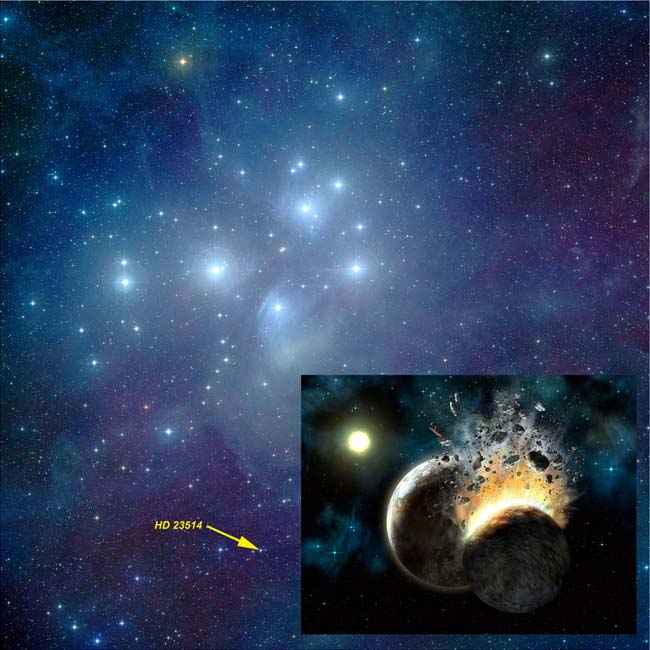
Evidence for rocky planets has been found in one of humanity's most beloved star clusters.
Astronomers have spotted a thick cloud of dust surrounding a star in the Pleiades, or "Seven Sisters," star cluster that they speculate is debris created from the collisions of rocky planet embryos or full-fledged planets.
"Our observations indicate that terrestrial planets similar to those in our solar system are probably quite common," said Benjamin Zuckerman, an astronomer at the University of California, Los Angeles, who was involved in the discovery.
The findings will be detailed in an upcoming issue of the Astrophysical Journal.
Using the Gemini Observatory and NASA's Spitzer Space Telescope, the researchers found that dust surrounding HD 23514, a star in the Pleiades that is slightly more massive and bright than our sun, is hundreds of thousands of times thicker than in our solar system.
While very young stars 10 million years old or younger are typically cloaked in thick dust clouds, HD 23514 is about 100 million years old, and its "primordial" dust should have long dissipated away. Thus, the dust that astronomers are seeing now is likely second-generation debris generated by the collision of large objects.
"In the process of creating rocky, terrestrial planets, some objects collide and grow into planets, while others shatter into dust," said study team member Inseok Song at Caltech. "We are seeing that dust."
Breaking space news, the latest updates on rocket launches, skywatching events and more!
The team calculates that terrestrial planets or planetary embryos in the Pleiades collided within the last few hundred thousand years and perhaps much more recently.
Particles created during the collisions could, in time, coalesce to form comets and asteroids or even new planets.
The Pleiades was well known throughout recorded human history. The ancient Greeks named it the Seven Sisters after its most visible hot blue stars; the Aztecs of Mexico and Central America based their calendar upon the Pleiades; and the cluster is mentioned in the Bible, when God asks Job, "Can you bind the beautiful Pleiades? Can you loose the cords of Orion?"
The Pleiades actually contains a total of about 1,400 stars. At 400 light years away in the constellation Taurus, it is one of the closest star clusters to Earth.
- Video: Planet Hunters
- Top 10 Star Mysteries
- Top 10 Most Intriguing Extrasolar Planets
Ker Than is a science writer and children's book author who joined Space.com as a Staff Writer from 2005 to 2007. Ker covered astronomy and human spaceflight while at Space.com, including space shuttle launches, and has authored three science books for kids about earthquakes, stars and black holes. Ker's work has also appeared in National Geographic, Nature News, New Scientist and Sky & Telescope, among others. He earned a bachelor's degree in biology from UC Irvine and a master's degree in science journalism from New York University. Ker is currently the Director of Science Communications at Stanford University.
